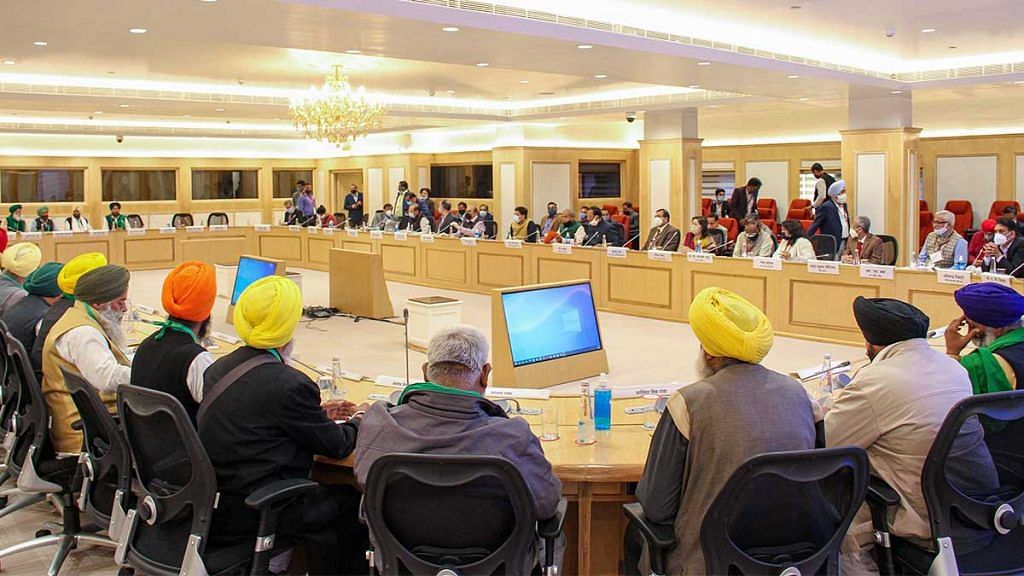As Union ministers Rajnath Singh, Amit Shah and Narendra Singh Tomar meet at Prime Minister Narendra Modi’s residence ahead of another round of talks, there are several lessons from the ongoing agitation at Delhi borders largely by farmers of Punjab, Haryana, Uttar Pradesh and Rajasthan.
The first and the most important is that legislating through the ordinance route is fraught with risks, and not desirable in our federal polity especially on subjects that are substantially in the domain of states. The framers of the Constitution had treated agriculture as a local issue and given its jurisdiction to states under the scheme of distribution of powers. It is the state governments that are closer to people, and, therefore, there is a need for deep consultation with them on issues relating to agriculture. The model that was adopted to evolve consensus over the GST legislation would be a more desirable approach in future too.
Under Article 123 of the Constitution, the President can promulgate an ordinance when Parliament is not in session. Executive powers of making laws through ordinances are to be sparingly used only in emergency situations when circumstances justify taking ‘immediate action’. There is a view that the three agriculture legislations did not really warrant immediate action, that too during the Covid-19 pandemic and lockdown.
Also read: Farmers’ problem is income, more than prices. Solution lies in setting up factories
The protests in Punjab, Haryana and other states could have been avoided had the normal process of legislation through Parliament been followed in the first place. That would have allowed wider consultation with the farmer organisations, state governments as well as other stakeholders.
In the past, there have been several examples of ordinances not becoming laws. The Land Acquisition Ordinance was promulgated thrice before it was allowed to lapse in August 2015.
Also read: Thatcher or Anna moment? Why Modi’s choice on farmers’ protest will shape future politics
The procurement problem
The second lesson is that Twitter and social media warriors do not reflect India’s collective wisdom. Only the ignorant can question the contribution of the original Green Revolution states – Punjab, Haryana and western UP – in providing food security to India for four decades. Many in the urban middle classes have questioned the subsidies provided to agriculture in Punjab as if other states do not provide any support to their farmers. They may be unaware that Andhra Pradesh, Karnataka, Telangana and Tamil Nadu also provide free electricity to their farmers.
The third lesson is that various states are at different stages of development, and formulation of a pan-India policy for agriculture may not be desirable.
Punjab and Haryana have invested large sums of money in setting up a robust mandi infrastructure through Agricultural Produce Market Committees (APMCs), but several other states are lagging behind. Due to the efforts of Punjab and Haryana, almost all farmers enjoy the benefit of realising minimum support price (MSP) for their wheat and paddy. In several other states, even though the APMC mandi infrastructure exists, most trading takes place outside mandis. In these states, the farmers have given up any hope of realising a fair price for their produce. That is why they are not protesting actively.
However, it must be noted that there has been good progress in this direction since the global food crisis of 2006-07, and several states have created an effective procurement system, mostly through co-operatives, which has successfully enabled farmers to benefit from procurement at MSP. Punjab and Haryana contributed to 69.5 per cent of the wheat procured in 2009-10. Their share had come down to 51.6 per cent in 2020-21. Similarly, their share in rice procurement has come down from 34.6 per cent in 2009-10 to 29.7 per cent in 2019-20 (kharif marketing season). Madhya Pradesh has procured more wheat this year than Punjab and Odisha; Andhra Pradesh and Telangana have procured a record high quantity of rice this year.
In 2015-16, the Union government decided to create a buffer of two million tonne of pulses, and the National Agricultural Cooperative Federation of India (NAFED) was made the nodal agency for this. Maharashtra, Karnataka, and Madhya Pradesh have helped their pulse-growing farmers get MSP during the years when market prices were at record lows. This has substantially reduced India’s dependence on imported pulses.
Also read: No takers for govt’s offer to amend farm laws, farmers say nothing short of repeal acceptable
A 10-year plan
Finally, the farmers of Punjab, Haryana and western UP also know that the wheat-rice cycle cannot continue indefinitely. Having seen the benefits of stable income through the sale of their produce at MSP, they are rightly anxious about the possibility of other crops not being procured by the government. They have the example of kharif crop maize this year that fetched them only Rs 1,000-1,200 per quintal while the MSP is Rs 1,850 per quintal. They are scared that a similar future awaits them for wheat and paddy.
After the talks with the farmers’ unions on 5 December 2020, it has to be seen if the farmers would be satisfied with just an assurance of the continuation of the current policy of MSP through an executive order, or would they stick to their demand for amendment in the law. What the farmers of Punjab, Haryana, western UP need is a 10-year plan to reduce the area under water-guzzling crops of paddy and sugarcane. But, coming from the original Green Revolution states, they need direct income support, shared equally by the Centre and the states, to compensate them for this switchover.
Punjab and Haryana are too precious for Indian agriculture and food security. The Modi government knows this and, therefore, it has shown wisdom in initiating negotiations and offering to make suitable amendments in legislation.
Hussain is retired Union Agriculture Secretary. Currently, he is Visiting Senior Fellow, ICRIER. Mohapatra retired as Union Fertiliser Secretary. Views are personal.
